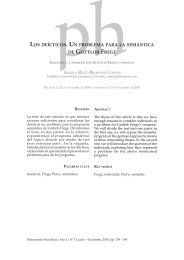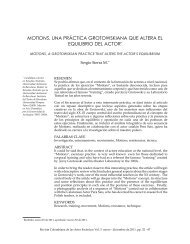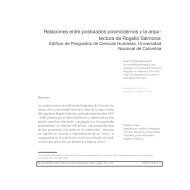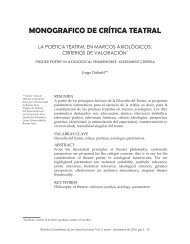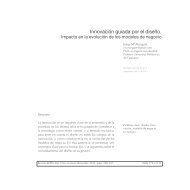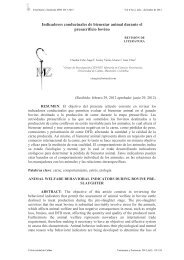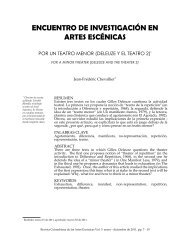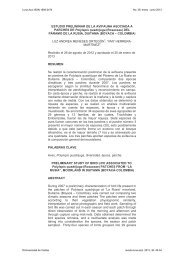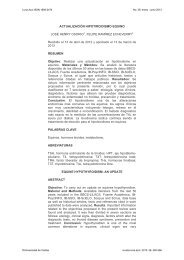coleoptera: scarabaeidae: scarabaeinae
coleoptera: scarabaeidae: scarabaeinae
coleoptera: scarabaeidae: scarabaeinae
Create successful ePaper yourself
Turn your PDF publications into a flip-book with our unique Google optimized e-Paper software.
ISSN 0123 - 3068 bol.cient.mus.hist.nat. 16 (1): 261 - 265<br />
SHORT COMUNICATION<br />
BOLETÍN CIENTÍFICO<br />
CENTRO DE MUSEOS<br />
MUSEO DE HISTORIA NATURAL<br />
COPROPHANAEUS MORENOI ARNAUD, 1982 (COLEOPTERA:<br />
SCARABAEIDAE: SCARABAEINAE) IN THE GORGONA NATIONAL<br />
NATURAL PARK (COLOMBIAN PACIFIC OCEAN)<br />
abstract<br />
Carlos A. Cultid Medina 1 and Alan Giraldo López 2<br />
A new record of the dung beetle Coprophanaeus morenoi Arnaud, 1982 (Coleoptera:<br />
Scarabaeidae: Scarabaeinae), for the Gorgona Natural National Park (Gorgona NNP, Colombia)<br />
in the Colombian Pacific Ocean is presented.<br />
Key words: Coleoptera, Gorgona Natural National Park, Pacific Ocean, Scarabaeinae.<br />
COPROPHANAEUS MORENOI ARNAUD, 1982 (COLEOPTERA:<br />
SCARABAEIDAE: SCARABAEINAE) EN EL PARQUE NATURAL<br />
NACIONAL GORGONA (OCÉANO PACÍFICO COLOMBIANO)<br />
resumen<br />
Se presenta un nuevo registro del escarabajo estercolero Coprophanaeus morenoi<br />
Arnaud, 1982 (Coleoptera: Scarabaeidae: Scarabaeinae), para el Parque Natural<br />
Nacional Gorgona, en el océano Pacifico colombiano.<br />
Palabras clave: Coleoptera, Parque Natural Nacional Gorgona, océano Pacifico, Scarabaeinae.<br />
A<br />
new record of the subfamily Scarabaeinae is presented for the Gorgona<br />
National Natural Park (Gorgona NNP, Colombia), this record is represented<br />
by Coprophanaeus morenoi Arnaud, 1982 (Coleoptera: Scarabaeidae). The<br />
known records for this species are from the biogeographic Chocó and Central<br />
America (Figure 1) (EDMONDS & ZIDEK, 2010). In Colombia C. morenoi has been<br />
captured only in continental locations of the states of Antioquia, Chocó, Nariño<br />
and Valle del Cauca, at altitudes ranging from 35 to 2200 masl (tropical rainforest<br />
and montane forest) (PARDO-LOCARNO, 1997; PARDO & CASTILLO, 2002a, 2002b;<br />
NEITA et al., 2003; VÍTOLO, 2004; PARDO-LOCARNO, 2007). This record is the first<br />
* Fr: 25-I-2012. FA: 25-V-2012.<br />
1 research Group in Biology, ecology and Ant Management. department of Biology, school of natural and<br />
exact sciences, universidad del Valle, Cali, Colombia. doctoral student in sciences, Biology. email: carlos.<br />
cultid@gmail.com.<br />
2 research Group in Animal ecology. department of Biology, school of natural and exact sciences,<br />
universidad del Valle, Cali, Colombia. email: ecologia@univalle.edu.co.
ol.cient.mus.hist.nat. 16 (1): 261 - 265<br />
262<br />
Carlos A. Cultid Medina and Alan Giraldo López<br />
for this genus in a colombian island and the first insular report for this species (D.<br />
Edmonds com. pers.). To date, there are few insular records of Scarabaeinae for<br />
Colombia: the original description of Uroxys gorgon in the same island (ARROW,<br />
1933), the record of the genus Deltorhinum in the island of Tierra Bomba-Bolivar<br />
(MEDINA & LOPERA-TORO, 2000) and the reports of Digitonthophagus gazella, (an<br />
exotic species) in San Andres island (NORIEGA et al., 2006).<br />
a.<br />
figure 1.<br />
A) Distribution of Coprophanaeus morenoi (based on EDMONDS & ZIDEK,<br />
2010); and B) location of specimens collected on Gorgona Island (right, midcenter),<br />
in parentheses specifies the year of collection.<br />
The Gorgona NNP covers approximately 61,700 hectares, which includes Gorgona<br />
and Gorgonilla islands, and a protected marine area (UAESNNP, 1998). An<br />
exploratory sampling was carried out for 24-h on Trinidad Hill (Gorgona Island)<br />
from 1-2 July 2011. Six pitfall traps baited with carrion (decomposing fish; alcohol<br />
as a preservative) were installed every 30 m in an altitudinal range from 40 to<br />
300 masl (2°58’3.4’’ N - 78°10’45.2’’ W and 2°58’3.4’’ N - 78°10’55.2 W) (Figure 1) in<br />
which only two females of C. morenoi were captured. During this sampling were<br />
not captured any other species of Scarabaeinae. The taxonomic determination<br />
of the collected females was performed at the Museum of Entomology, of the<br />
Universidad del Valle (MUSENUV) in Cali. A male specimen of C. morenoi, was<br />
found among the material deposited in the collection and it was collected at<br />
300 m (2°57’10”N – 78°10’13.20’’W) on Trinidad Hill on 15 may 1988, using a<br />
pitfall trap baited with carrion (Quesada B. L. leg.). All the specimens are currently<br />
housed at MUSENUV (Figure 2).<br />
B.
figure 2.<br />
Short comunication. Coprophanaeus morenoi Arnaud 263<br />
Specimens of Coprophanaeus morenoi collected on Gorgona Island. A) Female,<br />
collected in 2011 for authors; B) Male, collected in 1988; C) Male adeagus<br />
(dorsal view); and D) Male adeagus (lateral view). Photos: Cultid C. A. ©<br />
(scale in mm).<br />
The females of C. morenoi are similar to those of Coprophanaeus corythus, a<br />
common species in the biogeographic Chocó region. The C. morenoi females<br />
can be distinguished from those of C. corythus because its cephalic carina is<br />
positioned near middle distance of the head; thus the frontal region of head<br />
(frons) is longer than the clypeus (Figure 2a); in C. corythus the cephalic carina<br />
is located toward the posterior part of the head so the clypeus is longer than<br />
the frons. The C. morenoi male has a pronotal quadrilobate prominence with<br />
lobes linked by thick carinae; the prominence is flanked by broad concavities (In<br />
Panamá, there has been dimorphism between males with respect to prominence<br />
pronotal); the declivitous surface of the pronotum beneath the carina is smooth,<br />
without sculpturing (Figure 2b); and the parameres have a wide subapical tooth<br />
(EDMONDS & ZIDEK, 2010) (Fig. 2c y d).<br />
Gorgona Island, which is located 30 linear km from the Colombian Pacific<br />
Coast, arose in the Upper Mesozoic Era or Lower Tertiary (Paleogene) period<br />
(ECHEVERRÍA, 1986; GÓMEZ, 1986), associated with a lava flow (LLINÁS et al.,<br />
1990) that cooled rapidly upon entering in contact with the seawater (ARNDT<br />
et al., 1997; KERR, 2005). According to AGUIRRE & RANGEL (1993), there was a<br />
land connection between Gorgona Island and the continent during the Pleistocene
ol.cient.mus.hist.nat. 16 (1): 261 - 265<br />
264<br />
Carlos A. Cultid Medina and Alan Giraldo López<br />
epoch, which could explain the presence of C. morenoi on the island. It has been<br />
documented that C. morenoi is a copro-necrophagous species (PARDO-LOCARNO,<br />
1997; PARDO & CASTILLO, 2002a, 2002b; PARDO-LOCARNO, 2007; VÍTOLO,<br />
2004), an attribute that favors its permanence on the island because it does not<br />
depend exclusively on the excrement of vertebrates.<br />
It is important to note that despite of the use of a standard method of sampling, it<br />
was only possible to catch two female individuals during the exploratory sampling<br />
conducted in 2011. According to preliminary lists, in continental localities of the<br />
biogeographical Chocó, the abundance of C. morenoi ranges between 1 and 19<br />
individuals (MEDINA & KATTAN, 1996; PARDO - LOCARNO & CASTILLO, 2002a,<br />
2002b; PARDO - LOCARNO, 2007). In addition, C. corythus has also been listed<br />
for the biogeographic Chocó region (e.g. as its synonym C. telamon corythus, see<br />
EDMONDS & ZIDEK, 2010), It is likely that some specimens of C. morenoi had been<br />
misidentified as C. telamon in the past. A careful review of this material would<br />
probably result in an increase of the number of specimens and records of C. morenoi<br />
reported in continental locations.<br />
The authors are grateful to the MUSENUV for permitting us to study one of the<br />
specimens (male) and access the information from the collection. Thanks to<br />
María del Carmen Zúñiga and Ranulfo González, for their unconditional support<br />
in preparing this report and to Carlos Saavedra-Rodríguez, Diana Torres and<br />
Jennifer Girón for their comments on the text. We thank Dr. David Edmonds to<br />
confirm the taxonomic identification and thank to the evaluator for his comments<br />
to the document. This report forms part of the research project “Evaluation of<br />
the current state of the targets of faunistic conservation on Gorgona Island: A<br />
holistic approximation of the ecological assessment of Gorgona NNP - CI7820,”<br />
co-financed by the Universidad del Valle, the Squalus Foundation, Conservation<br />
International-Colombia and the Fund for Environmental Action and Childhood.<br />
We are also grateful to the National Parks of Colombia. Carlos A. Cultid is a<br />
doctoral student in the Biological Sciences Graduate Program of the Universidad<br />
del Valle (Cali - Valle del Cauca), which is supported by COLCIENCIAS funds for<br />
doctoral-level education in Colombia.<br />
BiBlioGraPHY<br />
AGUIRRE, J. & RANGEL, O., 1993.- La isla Gorgona y sus ecosistemas: 106-170 (in) LEYVA, P. (ed.) Colombia<br />
Pacífico, Volumen I. Fondo para la Protección del Medio Ambiente (FEN), Bogotá, Colombia.<br />
ARNDT, N. T., KERR, A. C. & TARNEY, J., 1997.- Dynamic melting in plume heads: The formation of Gorgona<br />
komatiites and basalts. Earth Planet Science Letters, 146: 289-301.<br />
ARROW, G. 1933.- The genus Uroxys (Coleoptera, Copridae), with descriptions of some new species.<br />
Annals and Magazine of Natural History, 10 (11): 385-399.<br />
ECHEVERRÍA, L. M., 1982.- Komatiites from Gorgona Island, Colombia: 199-209 (in) ARNDT, N. T. & NISBET,<br />
E. G. (eds.) Komatiites. Georfe Allen and Unwin, London, UK.<br />
EDMONDS, W. D. & ZIDEK, J., 2010.- A taxonomic review of the neotropical genus Coprophanaeus Olsoufieff,<br />
1924 (Coleoptera: Scarabaeidae, Scarabaeinae). Insecta Mundi, 0129: 1-111.<br />
GÓMEZ, H., 1986.- Algunos aspectos neotectónicos hacia el suroeste del Litoral Pacífico colombiano.<br />
Revista CIAF, 11: 281-289.<br />
KERR, A. C., 2005.- La Isla de Gorgona, Colombia: A petrological enigma? Lithos, 84: 77-101.<br />
LLINÁS, R., PINTO, J., PEÑA, F. & CARO, F., 1990.- Geología: 65-72 (in) RANCEL, O. & AGUIRRE, J. (eds.) Biota<br />
y ecosistemas de Gorgona. Fondo para la Protección del Medio Ambiente (FEN), Bogotá, Colombia.<br />
MEDINA, C. & KATTAN, G., 1996.- Diversidad de coleópteros coprófagos (Scarabaeidae) de la reserva natural<br />
de Escalerete. Cespedecia, 21: 89-102.
Short comunication. Coprophanaeus morenoi Arnaud 265<br />
MEDINA, C. A. & LOPERA-TORO, A., 2000.- Clave ilustrada para la identificación de géneros de escarabajos<br />
coprófagos (Coleoptera: Scarabaeinae) de Colombia. Caldasia, 22 (2): 299-315.<br />
NEITA, J. C., PARDO – LOCARNO, L., QUINTO, D. & CUESTA, N. G., 2003. - Los Escarabajos copronecrófilos<br />
(Coleoptera: Scarabaeidae) en la parcela permanente de investigación en biodiversidad (PPIB) en Salero,<br />
Unión Panamericana, Chocó: 79-90 (in) GARCÍA, F., RAMOS, Y. A., PALACIOS, J. C., ARROYO, J. E.,<br />
MENA, A. & GONZÁLEZ, M. (eds.) Salero: Diversidad Biológica de un Bosque Pluvial Tropical (bp-T).<br />
Universidad Tecnológica del Chocó, Instituto de Investigaciones Ambientales del Pacífico y Comunidad<br />
de Salero, Unión Panamericana, Chocó.<br />
NORIEGA, J., SOLIS, C., QUINTERO, I., PÉREZ, L. G., GARCÍA, H. G. & OSPINO, D. A., 2006.- Registro continental<br />
de Digitonthophagus gazella (Coleoptera: Scarabaeidae) en Colombia. Caldasia, 28 (2): 379-381.<br />
PARDO-LOCARNO, L., 1997.- Muestreo preliminar de los escarabajos copronecrófilicos (Coleoptera-<br />
Scarabaeidae) de las selvas de la Fragua, cuenca baja río Cajambre (Valle). Cespedecia, 22 (69): 59-80.<br />
PARDO-LOCARNO, L. & CASTILLO, L. D., 2002a.- Muestreo preliminar de los escarabajos copronecrófilos<br />
(Coleoptera-Scarabaeidae) de las selvas de Chancos, Calima, Chocó biogeográfico (Valle). Bol. Cien.<br />
Mus. Hist. Nat. U. de Caldas, 6 (1): 11-27.<br />
PARDO-LOCARNO, L. & CASTILLO, L. D., 2002b.- Contribución al estudio de los escarabajos coprónecrofilos<br />
(Col. Scarabaeidae) de la quebrada, río Azul, Calima, Chocó biogeográfico, Colombia. Bol. Cien. Mus.<br />
Hist. Nat. U. de Caldas, 6 (1): 161-176.<br />
PARDO-LOCARNO, L., 2007.- Escarabajos coprófagos (Coleoptera-Scarabaeidae) de Lloró, departamento<br />
del Chocó, Colombia. Bol. Cien. Mus. Hist. Nat. U. de Caldas, 11 (1): 377-388.<br />
UASPNN., 1998.- El sistema de Parques Nacionales Naturales de Colombia. Unidad Administrativa Especial<br />
del Sistema de Parques Nacionales Naturales (UASPNN), Ministerio del Medio Ambiente. Editorial<br />
Nomos, Bogotá, Colombia.<br />
VÍTOLO, A., 2004.- Escarabajos estercoleros de la tribu Phanaeini de Colombia (Coleoptera: Scarabaeoidea:<br />
Scarabaeidae): 277-318 (in) FERNÁNDEZ, F., ANDRADE, M. G. & AMAT, G. (eds.) Insectos de Colombia,<br />
Volumen 3. Facultad de Ciencia, Universidad Nacional de Colombia, Bogotá, Colombia.



